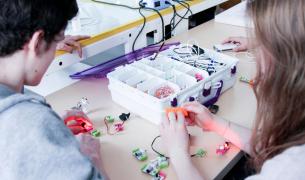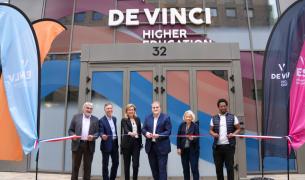
Charles deGrazia holds a PhD from the University of London. Prior to joining EMLV, Charles worked as an economist at the U.S. Patent and Trademark Office and as an associate instructor at Indiana University. His research interests include economics and management of innovation, economics of intellectual property, innovation strategy, innovation policy, and applied microeconomics. Charles has been published in journals including Research Policy, Industry and Innovation, and the Economics of Innovation and New Technology.
Charles de Grazia; Alexander Giczy; Nicholas Pairolero
Procrastination or incomplete data? An analysis of USPTO examiner search activity Article de journal
Dans: Research Policy, vol. 53, no. 7, p. 105033, 2024.
@article{de_grazia_3030,
title = {Procrastination or incomplete data? An analysis of USPTO examiner search activity},
author = {Charles de Grazia and Alexander Giczy and Nicholas Pairolero},
url = {https://doi.org/10.1016/j.respol.2024.105033},
year = {2024},
date = {2024-09-01},
journal = {Research Policy},
volume = {53},
number = {7},
pages = {105033},
abstract = {Frakes and Wasserman (2020) finds evidence that United States Patent and Trademark Office (USPTO) patent examiners disproportionately receive credit for examination activities at the end of production periods and interprets this behavior as systemic examiner procrastination. Using newly assembled micro data on the
timing of USPTO examiner activities, our results show examiner work effort more closely resembles a uniform distribution over the production period, indicating consistent workflow and not procrastination. The assembled
data better track the precise timing of examiner work activities than the data used in Frakes and Wasserman
(2020), explaining the differences in our results. While Frakes and Wasserman (2020) conduct a thorough analysis of the markers and consequences of ??end-loading'', its use of an inadequate proxy for examination activity (i.e., Office action count dates) leads to incorrect conclusions about the examination process (i.e., widespread examiner procrastination)},
keywords = {},
pubstate = {published},
tppubtype = {article}
}
Charles de Grazia; Nicholas Pairolero; Mike Teodorescu
Examination incentives, learning, and patent office outcomes: The use of examiner's amendments at the USPTO Article de journal
Dans: Research Policy, vol. 50, no. 10, p. 104360, 2021.
@article{de_grazia_1581,
title = {Examination incentives, learning, and patent office outcomes: The use of examiner's amendments at the USPTO},
author = {Charles de Grazia and Nicholas Pairolero and Mike Teodorescu},
url = {https://www.sciencedirect.com/science/article/pii/S0048733321001578},
year = {2021},
date = {2021-12-01},
journal = {Research Policy},
volume = {50},
number = {10},
pages = {104360},
abstract = {We investigate how U.S. Patent and Trademark Office (USPTO) patent examiner experience and seniority-basedincentives affect the innovation ecosystem. First, we show that examiners respond to production incentivesand demonstrate learning by increasing the use of examiner's amendments in both experience and seniority,a mechanism not previously studied. Second, this examination procedure directly benefits innovators andfirms by significantly reducing prosecution processing time without impacting patent quality. Finally, afterconsidering examiner's amendments, the negative relationship between examiner characteristics and patentexamination quality found in the previous literature does not persist at first action, a decision point thatallows for the clear measurement of examiner behavior. Our results demonstrate a need for reformulatedpolicy recommendations related to the structure of examination at the USPTO.},
keywords = {},
pubstate = {published},
tppubtype = {article}
}
Charles de Grazia; Amanda Myers; Andrew Toole
Innovation activities and business cycles: are trademarks a leading indicator? Article de journal
Dans: Industry And Innovation, vol. 27, no. 1/2, p. 184-203, 2020.
@article{de_grazia_1350,
title = {Innovation activities and business cycles: are trademarks a leading indicator?},
author = {Charles de Grazia and Amanda Myers and Andrew Toole},
url = {https://www.tandfonline.com/doi/abs/10.1080/13662716.2019.1650252},
year = {2020},
date = {2020-01-01},
journal = {Industry And Innovation},
volume = {27},
number = {1/2},
pages = {184-203},
abstract = {Despite the widespread use of economic information to anticipate changes in business conditions, innovation metrics are not considered to be leading indicators. We argue that aggregate trademark data reflect firm-level choices that can help predict business cycles. In addition to establishing the conceptual basis for considering trademarks, our statistical evaluations, using turning point analysis and a novel machine learning method, find that trademark filings for product and service offerings in commercial use outperform many of the conventional leading indicators. Our work suggests that including trademark metrics in composite indexes could improve recession forecasting performance.},
keywords = {},
pubstate = {published},
tppubtype = {article}
}
Charles de Grazia; Jesse P. Frumkin; Nicholas Pairolero
Embracing invention similarity for the measurement of vertically overlapping claims Article de journal
Dans: Economics Of Innovation And New Technology, vol. 29, no. 2, p. 113-146, 2020.
@article{de_grazia_1351,
title = {Embracing invention similarity for the measurement of vertically overlapping claims},
author = {Charles de Grazia and Jesse P. Frumkin and Nicholas Pairolero},
url = {https://www.tandfonline.com/doi/abs/10.1080/10438599.2019.1593035},
year = {2020},
date = {2020-01-01},
journal = {Economics Of Innovation And New Technology},
volume = {29},
number = {2},
pages = {113-146},
abstract = {Clear and well-defined patent rights can incentivize innovation by granting monopoly rights to the inventor for a limited period of time in exchange for public disclosure of the invention. However, with cumulative innovation, when a product draws from intellectual property held across multiple firms (including fragmented intellectual property or patent thickets), contracting failures may lead to suboptimal economic outcomes. However, an alternative theory, developed by a variety of scholars, contends that patent thickets have a more ambiguous effect. Researchers have developed several measures to gauge the extent and impact of cumulative innovation and the various channels of patent thickets. This paper contends that mis-measurement may contribute to the incoherence and overall lack of consensus within the patent thickets literature. Specifically, the literature is missing a precise measure of vertically overlapping claims. We propose a new measure of vertically overlapping claims that incorporates invention similarity to more precisely identify inventive overlap. The measure defined in this paper will enable more accurate measurement, and allow for novel economic research on cumulative innovation, fragmentation in intellectual property, and patent thickets within and across all patent jurisdictions.},
keywords = {},
pubstate = {published},
tppubtype = {article}
}
Alan Marco; Joshua Sarnoff; Charles de Grazia
Patent claims and patent scope Article de journal
Dans: Research Policy, vol. 48, no. 9, p. 103790, 2019.
@article{marco_1349,
title = {Patent claims and patent scope},
author = {Alan Marco and Joshua Sarnoff and Charles de Grazia},
url = {https://www.sciencedirect.com/science/article/abs/pii/S0048733319301052},
year = {2019},
date = {2019-11-01},
journal = {Research Policy},
volume = {48},
number = {9},
pages = {103790},
abstract = {x},
keywords = {},
pubstate = {published},
tppubtype = {article}
}
Charles de Grazia; Amanda Myers; Andrew Toole
Innovation Activities and Business Cycles: Are Trademarks a Leading Indicator? Book Section
Dans: Jörn Block Carolina Castaldi, Meindert J. Flikkema (Ed.): Trademarks and Their Role in Innovation, Entrepreneurship and Industrial Organization, vol. 1, Routledge, 2021, ISBN: 9780367706647.
@incollection{de_grazia_1587,
title = {Innovation Activities and Business Cycles: Are Trademarks a Leading Indicator?},
author = {Charles de Grazia and Amanda Myers and Andrew Toole},
editor = {Carolina Castaldi, Jörn Block, Meindert J. Flikkema},
url = {https://www.routledge.com/Trademarks-and-Their-Role-in-Innovation-Entrepreneurship-and-Industrial/Castaldi-Block-Flikkema/p/book/9780367706647},
issn = {9780367706647},
year = {2021},
date = {2021-06-01},
booktitle = {Trademarks and Their Role in Innovation, Entrepreneurship and Industrial Organization},
volume = {1},
publisher = {Routledge},
keywords = {},
pubstate = {published},
tppubtype = {incollection}
}
Charles de Grazia; Nicholas Pairolero; Mike Teodorescu; Peter-Anthony Pappas
Patents and the Independent Inventor Lifecycle Proceedings Article
Dans: Patents and the Independent Inventor Lifecycle, Seattle, Washington, USA, 2022, ISBN: 2151-6561.
@inproceedings{de_grazia_2225,
title = {Patents and the Independent Inventor Lifecycle},
author = {Charles de Grazia and Nicholas Pairolero and Mike Teodorescu and Peter-Anthony Pappas},
url = {https://journals.aom.org/doi/abs/10.5465/AMBPP.2022.199},
issn = {2151-6561},
year = {2022},
date = {2022-07-01},
booktitle = {Patents and the Independent Inventor Lifecycle},
address = {Seattle, Washington, USA},
abstract = {We present results from the first ever randomized control trial on independent inventors at the United States Patent and Trademark Office. This experiment, called the Pro Se Pilot, led to an 8 percentage point increase in the likelihood of receiving a patent. We exploit the random assignment of treatment to identify causal impacts of receiving a patent on short term independent inventor outcomes. Our results suggest that patenting is key to inventive, innovative, and entrepreneurial activity. We find large effect sizes of patenting on reducing financial frictions, participating in markets for technology (18.7 pp), and signaling inventor value to established firms (24.8 pp).},
keywords = {},
pubstate = {published},
tppubtype = {inproceedings}
}
Nicholas Pairolero; Andrew Toole; Peter-Anthony Pappas; Charles de Grazia; Mike Teodorescu
Closing the Gender Gap in Patenting: Evidence from a Randomized Control Trial at the USPTO Proceedings Article
Dans: Closing the Gender Gap in Patenting: Evidence from a Randomized Control Trial at the USPTO, Seattle, Washington, USA, 2022, ISBN: 2151-6561.
@inproceedings{pairolero_2226,
title = {Closing the Gender Gap in Patenting: Evidence from a Randomized Control Trial at the USPTO},
author = {Nicholas Pairolero and Andrew Toole and Peter-Anthony Pappas and Charles de Grazia and Mike Teodorescu},
url = {https://journals.aom.org/doi/abs/10.5465/AMBPP.2022.197},
issn = {2151-6561},
year = {2022},
date = {2022-07-01},
booktitle = {Closing the Gender Gap in Patenting: Evidence from a Randomized Control Trial at the USPTO},
address = {Seattle, Washington, USA},
abstract = {Women are underrepresented in patenting and the gap is not closing quickly. The challenge for policy is that the sources of this gap are complex and not well understood. Using a randomized control trial (RCT) at the United States Patent and Trademark Office (USPTO), we identify the heterogeneous causal impacts (across gender) of increased patent examination assistance on the probability of obtaining patent rights. Women applicants were 11 percentage points more likely than men to benefit from this assistance, and the benefits were largest for new inventors, and in areas of technology where women have the worst relative outcomes.},
keywords = {},
pubstate = {published},
tppubtype = {inproceedings}
}
Charles de Grazia
Patents and the Independent Inventor Lifecycle Divers
FNEGE Médias, 2023.
@misc{de_grazia_2866,
title = {Patents and the Independent Inventor Lifecycle},
author = {Charles de Grazia},
url = {https://fnege-medias.fr/fnege-video/les-brevets-et-le-cycle-de-vie-de-linventeur-independant/},
year = {2023},
date = {2023-06-01},
howpublished = {FNEGE Médias},
note = {In this paper, we leverage the first randomized control trial of inventors at the USPTO to demonstrate that granted patent rights provide substantial benefits to independent inventors. We also find that the nature of these benefits differs by inventor type. For financially-constrained Pro se inventors from the USPTO experiment, patents act as a signal and increase the likelihood of affiliation. For the broader set of independent inventors, however, patents reduce financial, informational, and commercialization frictions and increase subsequent inventive activity.},
keywords = {},
pubstate = {online},
tppubtype = {misc}
}
Andrew Toole; Amanda Myers; Charles de Grazia
Progress and potential: A profile of women inventors on US patents Rapport technique
2020.
@techreport{toole_2224,
title = {Progress and potential: A profile of women inventors on US patents},
author = {Andrew Toole and Amanda Myers and Charles de Grazia},
url = {https://www.uspto.gov/ip-policy/economic-research/publications/reports/progress-potential},
year = {2020},
date = {2020-07-01},
keywords = {},
pubstate = {published},
tppubtype = {techreport}
}
No posts by this author.
N'hésitez pas à contacter le service des admissions pour tout renseignement complémentaire :









